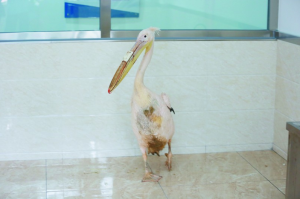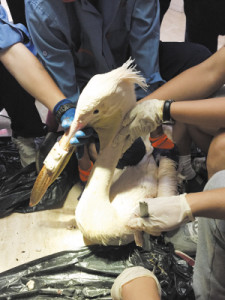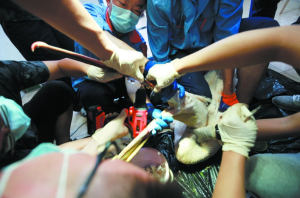Beautiful White Pelican Receives New Beak Thanks to 3D Printing Technology
3D printing has gradually made its way into the medical field. We’ve seen it used in numerous ways over the past few years to aid in the recovery of both humans and animals alike. Whether it is a prosthetic hand for a child, a prosthetic leg for a dog, or even a prosthetic foot for a turtle, the technology is going a long way to make a lot of people and animals happy again.
Now zoo workers at the Dalian Forest Zoo wildlife rescue center, have figured out a way to give a gorgeous white pelican a second chance at life through the help of 3D printing. It all started back in May of this year when zoo staff noticed that one of their 12 pelicans had been acting funny. Upon further examination, it was discovered that this pelican had severe damage to its beak.
“This pelican was very alert, but remained relatively far away from the staff,” Liu Wen-liang of the zoo explained. “Then, after repeated observation, the staff finally identified that this pelican had suffered a broken beak. This is an adult male pelican, and we speculate that it may have been damaged during a fight with his peers.”
A pelican’s beak is very important to its survival, as it is the means of eating food, and garnering respect from  other penguins. If this pelican’s beak was not fixed, he would eventually starve to death and completely lose any courtship that it had with its peers. The zoo workers decided that they needed to intervene, and help create a new beak for this unfortunate animal.
other penguins. If this pelican’s beak was not fixed, he would eventually starve to death and completely lose any courtship that it had with its peers. The zoo workers decided that they needed to intervene, and help create a new beak for this unfortunate animal.
First the method of fabricating a new beak involved using thick aluminum foil-like material. The first surgery appeared to be a success until the aluminum foil simply fell off after about a month. The second attempt involved drilling two holes in the beak and then attaching the aluminum to it with metal wire. This method also failed after the wire rusted out a few weeks ago, on August 4.
This is what led the zoo staff to try and come up with a better, more permanent solution.
“Because I heard that the city has a hospital that is using 3D printing technology to print out patients’ bones for surgical reference, we found help at Dalian Science and Technology Co., Ltd.,” explained Liu Wen-liang.
The original idea was to completely remove all remains of the pelican’s beak and then replace it with an entirely 3D  printed version, but after careful examination, doctors determined that the beak had appeared to exhibit some new growth, potentially meaning that it may eventually grow back on its own. This led to doctors to decide to preserve the portion of the beak that remained and instead they created an extension that would allow it to be full-sized again.
printed version, but after careful examination, doctors determined that the beak had appeared to exhibit some new growth, potentially meaning that it may eventually grow back on its own. This led to doctors to decide to preserve the portion of the beak that remained and instead they created an extension that would allow it to be full-sized again.
Using a mold that they made of the pelican’s beak, it was off to the drawing board to create a 3D printed partial beak that could be screwed into the pelican’s original piece of anatomy. The new beak exhibits the shape of a real beak and in theory should work the same as well. As you can see in the photos provided, this solution seems to be a legitimate long term one.
The new custom beak, which measures 5mm thick, mimics the natural grain of a real pelican’s beak, and zoo staff expect this will allow the pelican to lead a normal life. 3D printing allowed for the complete customization of this new beak, as the technology can be used to make exact replicas, down to the millimeter or smaller.
Zoo staff was happy to announce that the pelican had begun feeding on his own for the first time since the injury in May.
Source: 3dprint.com


